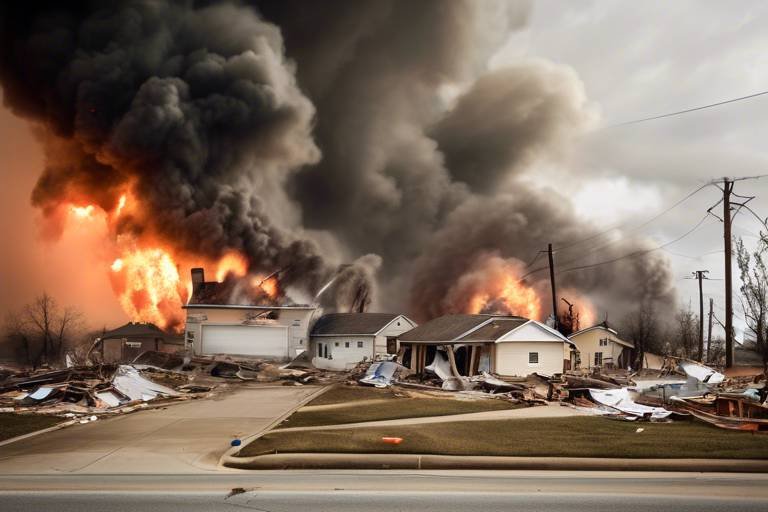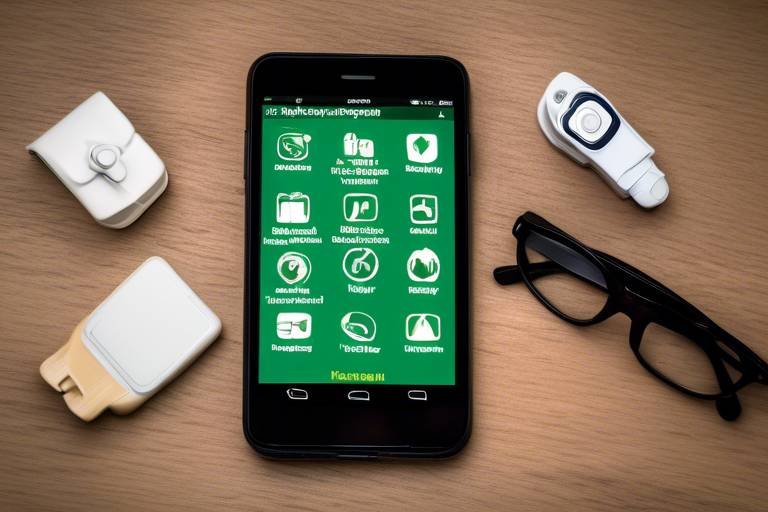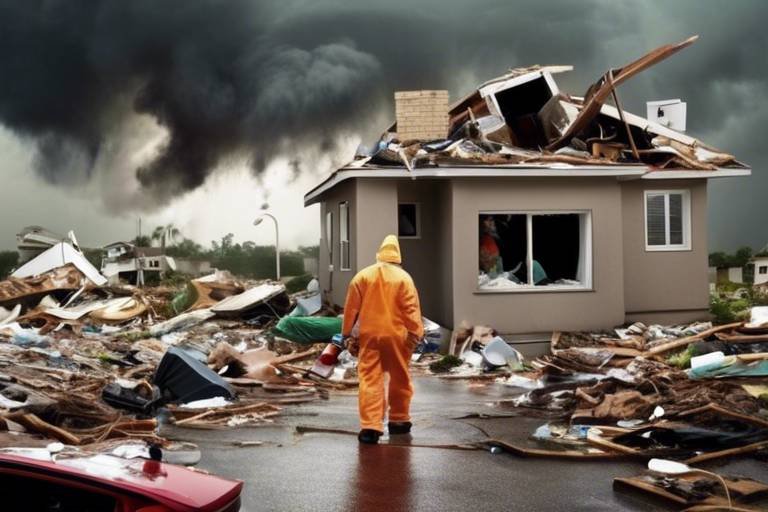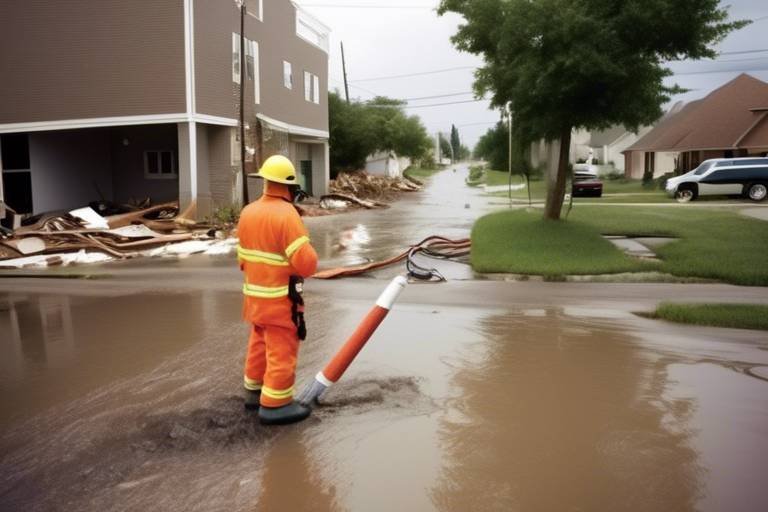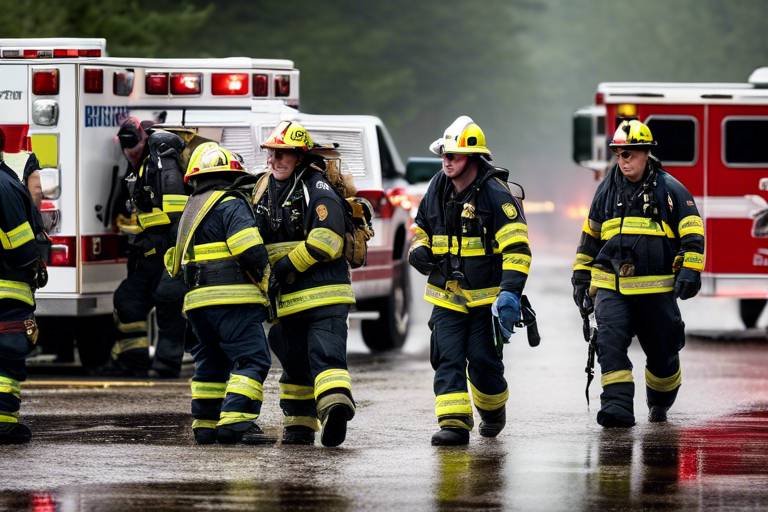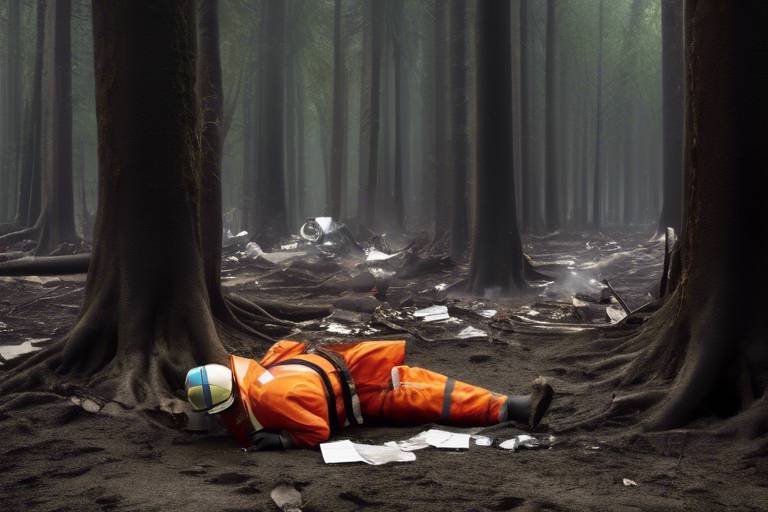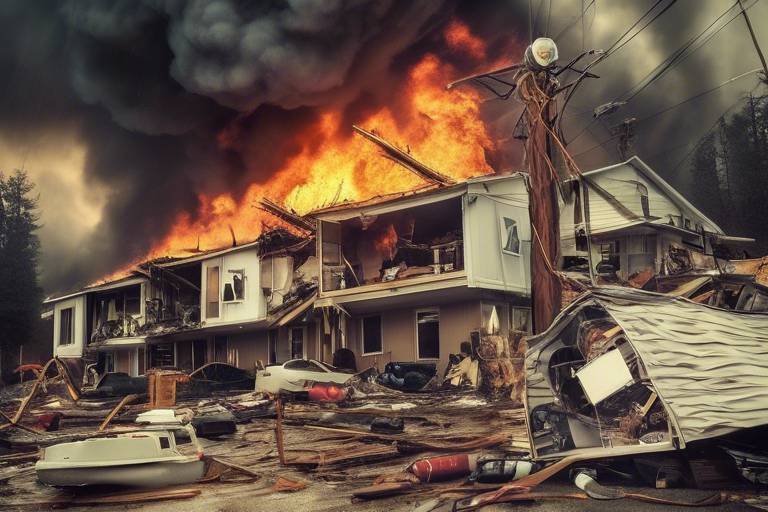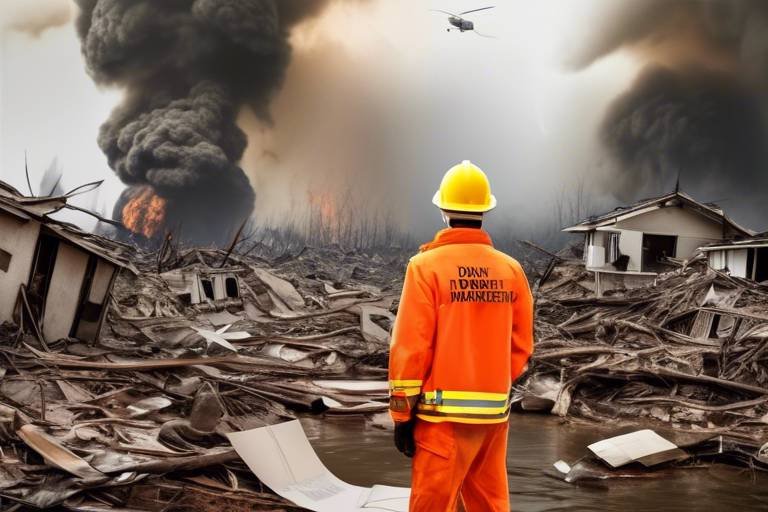The Role of NGOs in Disaster Management
When disaster strikes, it often feels like the world has turned upside down. In these chaotic moments, non-governmental organizations (NGOs) emerge as beacons of hope, playing a critical role in disaster management. They are not just passive observers; they are active participants who bring specialized knowledge, resources, and community connections to the table. Their involvement spans across various phases of disaster management, from preparedness to recovery and advocacy. This article delves into the multifaceted roles that NGOs play, emphasizing their importance in creating resilient communities capable of withstanding the shocks of natural and man-made disasters.
Disaster management is a comprehensive framework that encompasses a myriad of activities aimed at reducing risks, responding to emergencies, and facilitating recovery. Think of it as a well-oiled machine, where each part must function smoothly for the whole to work effectively. The phases of disaster management can be broken down into four key components: preparedness, response, recovery, and mitigation. Understanding these phases is essential for effective collaboration with NGOs, as they often serve as the bridge between communities and the resources they need to navigate through crises.
NGOs serve as vital partners in disaster management, acting as the glue that holds various efforts together. They bring specialized knowledge and resources that enhance overall response efforts. For instance, an NGO might have extensive experience in coordinating relief efforts or might possess unique insights into local vulnerabilities that government agencies may overlook. Their community connections are invaluable, as they often have established trust and rapport with the very people they seek to help. This trust can make all the difference in effectively mobilizing resources and support during a crisis.
Preparation is the first line of defense against disasters, and NGOs engage in this phase through a variety of activities. They conduct training sessions, educate communities about disaster risks, and mobilize resources to ensure that communities are ready to respond effectively when disasters strike. Imagine a community where residents know exactly what to do when an earthquake hits—thanks to the training provided by NGOs. This proactive approach not only saves lives but also mitigates the impact of disasters on communities.
During emergencies, the role of NGOs becomes even more pronounced. They coordinate relief efforts, deliver essential services, and mobilize volunteers, significantly impacting the immediate response to disasters. Picture a scene where a hurricane has just made landfall; NGOs are often the first responders on the ground, providing food, shelter, and medical assistance. Their ability to act swiftly and efficiently can mean the difference between life and death for those affected.
Once the immediate crisis has passed, NGOs shift their focus to recovery and rehabilitation. They play a crucial role in providing long-term support, rebuilding infrastructure, and helping communities regain their livelihoods. This phase is often overlooked, but it is just as vital as the response phase. Without sustained efforts, communities can struggle to bounce back. NGOs help to ensure that recovery is not just about returning to the status quo but about building back better, incorporating lessons learned from the disaster.
Beyond their hands-on work, NGOs also engage in advocacy and policy influence. They advocate for policies that enhance disaster resilience and support marginalized communities. By influencing government actions and funding priorities, NGOs can help shape a more effective disaster management landscape. Their voices can amplify the needs of those who are often overlooked in policy discussions, ensuring that disaster management strategies are inclusive and equitable.
Effective disaster management requires collaboration between NGOs and government agencies. This partnership ensures a unified approach that leverages resources and expertise for maximum impact. NGOs often bring innovative solutions and grassroots knowledge that complement governmental efforts. When these two entities work together, the result is a more coordinated response that can adapt to the unique challenges posed by different disasters.
However, the path is not always smooth for NGOs. They encounter various challenges during disaster management, including funding limitations, coordination issues, and navigating bureaucratic processes. These hurdles can hinder their effectiveness and slow down response times. For instance, a lack of funding may prevent an NGO from mobilizing quickly enough to meet urgent needs. Understanding these challenges is crucial for improving the overall disaster management system.
As disaster risks continue to evolve due to climate change and other factors, NGOs must adapt by embracing technology, fostering community engagement, and enhancing their capacity to respond to emerging challenges. This evolution is not just about keeping up; it’s about leading the charge in innovative disaster management practices that prioritize resilience and sustainability.
- What are the main functions of NGOs in disaster management? NGOs primarily focus on preparedness, response, recovery, and advocacy.
- How do NGOs contribute to community resilience? By providing training, resources, and support, NGOs empower communities to better prepare for and respond to disasters.
- What challenges do NGOs face during disaster management? Common challenges include funding limitations, coordination issues, and bureaucratic hurdles.
- How can NGOs and governments work together effectively? Collaboration is key; both parties should leverage their strengths for a more coordinated response.

Understanding Disaster Management
Disaster management is a comprehensive field that involves a series of strategic actions aimed at reducing risks, responding to emergencies, and facilitating recovery after disasters strike. It’s not just about reacting when a crisis occurs; it’s about being prepared and having a plan in place. Think of it like preparing for a big storm: you wouldn't wait until the rain starts to gather supplies or figure out where to go for safety, right? Similarly, effective disaster management encompasses several phases that require careful planning and execution.
The phases of disaster management can be broadly categorized into four key areas:
- Mitigation: This involves efforts to reduce the impact of disasters before they happen. It includes risk assessments, land-use planning, and implementing building codes to ensure structures can withstand potential disasters.
- Preparedness: This phase focuses on planning and training. It involves creating emergency plans, conducting drills, and educating communities about what to do in case of a disaster.
- Response: This is the immediate reaction to a disaster. It includes mobilizing resources, providing emergency services, and ensuring that affected populations receive the help they need as quickly as possible.
- Recovery: After the initial response, recovery efforts begin. This phase aims to restore the affected community to its previous state or even improve it. It includes rebuilding infrastructure, providing psychological support, and helping people regain their livelihoods.
Understanding these phases is crucial for effective collaboration with NGOs, as they often play a pivotal role in each stage. For instance, during the preparedness phase, NGOs can offer training programs and community workshops to ensure everyone knows how to respond in an emergency. In the response phase, they might coordinate relief efforts, ensuring that food, medical aid, and shelter reach those in need promptly. And in recovery, NGOs often lead initiatives to rebuild homes and restore essential services.
Moreover, disaster management is not just a technical process; it involves a human element that cannot be overlooked. Community engagement is vital. When communities are involved in the planning and execution of disaster management strategies, they become more resilient and better prepared to handle crises. This engagement can take many forms, from public meetings to social media campaigns that raise awareness about disaster preparedness.
In summary, understanding disaster management is about recognizing the interconnected phases that help societies prepare for, respond to, and recover from disasters. It’s a dynamic process that requires cooperation across various sectors, including government, NGOs, and the communities themselves. By grasping this concept, we can better appreciate the invaluable contributions that NGOs make in this field, enhancing the overall effectiveness of disaster management efforts.

The Importance of NGOs
Non-governmental organizations, or NGOs, are often the unsung heroes in the realm of disaster management. Their importance cannot be overstated, as they bring a unique blend of specialized knowledge, resources, and deep-rooted community connections that significantly enhance disaster response efforts. Think of them as the glue that holds various components of disaster management together, ensuring that each piece functions smoothly and effectively. But what exactly makes NGOs so vital in this arena?
First and foremost, NGOs have a profound understanding of the local context. They are usually embedded within the communities they serve, which allows them to grasp the specific needs and vulnerabilities of those populations. This local knowledge is invaluable during crises, where every second counts, and the right response can make all the difference. For instance, when a natural disaster strikes, NGOs can swiftly mobilize resources and tailor their interventions to address the unique challenges faced by the affected communities.
Moreover, NGOs often act as a bridge between affected communities and larger governmental and international organizations. They facilitate communication, ensuring that the voices of marginalized populations are heard in decision-making processes. This advocacy role is crucial, especially for those who might otherwise be overlooked. By representing the interests of vulnerable groups, NGOs can influence funding priorities and policy decisions, thereby enhancing the overall effectiveness of disaster management strategies.
In addition to advocacy and local knowledge, NGOs contribute significantly to resource mobilization. They have established networks and partnerships that allow them to gather essential supplies, funds, and volunteers quickly. For example, during major disasters, NGOs often coordinate with local businesses, international donors, and volunteers to create a robust support system. This collaborative effort ensures that resources are allocated efficiently and reach those in need without unnecessary delays.
Furthermore, NGOs play a pivotal role in training and educating communities about disaster preparedness. They conduct workshops, simulations, and educational campaigns that empower individuals with the knowledge and skills necessary to respond effectively in emergencies. This proactive approach not only saves lives but also fosters a culture of resilience within communities. When people are equipped with the right tools and information, they are more likely to act swiftly and effectively when disaster strikes.
In summary, the importance of NGOs in disaster management lies in their ability to blend local knowledge with advocacy, resource mobilization, and community education. They are not just responders; they are catalysts for change, driving efforts that lead to safer, more resilient communities. As we continue to face increasing disaster risks, the role of NGOs will only become more critical in shaping effective disaster management strategies.
- What are the main functions of NGOs in disaster management? NGOs engage in preparedness, response, recovery, and advocacy to support communities affected by disasters.
- How do NGOs influence disaster management policies? They advocate for marginalized communities, ensuring that their needs are represented in policy discussions and funding decisions.
- Why is local knowledge important in disaster response? Local knowledge helps NGOs tailor their interventions to the specific needs and vulnerabilities of affected populations, leading to more effective responses.
- How do NGOs mobilize resources during disasters? NGOs leverage established networks and partnerships to quickly gather supplies, funds, and volunteers, ensuring timely support for affected communities.

NGO Roles in Preparedness
When it comes to disaster preparedness, the role of non-governmental organizations (NGOs) is nothing short of pivotal. These organizations are often the unsung heroes, working tirelessly behind the scenes to ensure that communities are not only aware of potential risks but are also equipped to handle them. Imagine a community that is suddenly faced with a natural disaster—without the groundwork laid by NGOs, the chaos could be overwhelming. NGOs engage in various activities that help to bolster community resilience, making it essential for them to be involved in the preparatory phase.
One of the primary functions of NGOs in preparedness is training and capacity building. They conduct workshops and training sessions aimed at educating community members about disaster risks and response strategies. For instance, during a training session, participants might learn how to administer first aid, use emergency equipment, or even create evacuation plans. This knowledge is crucial; it empowers individuals to take action during a crisis rather than waiting for external help. Think of it as planting seeds of knowledge that can grow into a robust response system when disaster strikes.
Additionally, NGOs are instrumental in community education. They often utilize various platforms to disseminate information regarding disaster preparedness. This can include everything from distributing pamphlets and flyers to organizing community meetings where residents can learn about local hazards. By engaging with the community, NGOs foster a sense of ownership and responsibility among residents. When people are informed, they are more likely to take proactive steps to protect themselves and their families. The more prepared a community is, the less likely they are to suffer severe consequences during a disaster.
Resource mobilization is another critical aspect of how NGOs contribute to preparedness. They often work to gather and stockpile essential supplies that can be deployed in the event of a disaster. This might include food, water, medical supplies, and other necessities. Imagine a well-stocked emergency kit that can be accessed at a moment's notice; this is the kind of preparedness that NGOs strive to achieve. Furthermore, by establishing partnerships with local businesses and governments, NGOs can create a safety net of resources that can be quickly mobilized in times of need.
Moreover, NGOs play a crucial role in developing disaster response plans. They collaborate with local authorities to create comprehensive plans that outline the steps to be taken before, during, and after a disaster. This collaboration ensures that everyone is on the same page, reducing confusion and enhancing the overall effectiveness of the response. A well-structured plan can mean the difference between chaos and order during an emergency.
In conclusion, the roles of NGOs in disaster preparedness are multifaceted and deeply impactful. From training and community education to resource mobilization and planning, these organizations work tirelessly to equip communities with the tools they need to face emergencies head-on. Without their efforts, many communities would be left vulnerable and unprepared, highlighting the critical importance of their involvement in disaster management.
- What types of training do NGOs provide for disaster preparedness? NGOs often provide training in first aid, emergency response, evacuation planning, and risk assessment.
- How do NGOs mobilize resources for disaster preparedness? NGOs collaborate with local businesses, governments, and community members to gather supplies and create emergency kits.
- Why is community education important in disaster preparedness? Educating the community fosters a sense of responsibility and equips individuals with the knowledge to act effectively during a disaster.
- What is the significance of disaster response plans? These plans ensure that all stakeholders know their roles and responsibilities, minimizing confusion during emergencies.

NGOs in Emergency Response
When disaster strikes, the clock starts ticking, and every second counts. In these critical moments, non-governmental organizations (NGOs) become the unsung heroes, stepping in to provide immediate assistance and support to affected communities. Their role in emergency response is not just valuable; it's often essential for saving lives and alleviating suffering. Imagine a community grappling with the aftermath of a devastating earthquake, where roads are blocked, communication is shattered, and the local government is overwhelmed. This is where NGOs swoop in like a well-oiled machine, ready to coordinate relief efforts and deliver essential services.
NGOs have the unique ability to mobilize quickly, thanks to their established networks and resources. They often bring together teams of skilled professionals and dedicated volunteers, all eager to make a difference. These organizations are adept at assessing the needs of affected populations, ensuring that aid is directed where it is most needed. For instance, in the wake of a natural disaster, NGOs might set up emergency shelters, distribute food and water, and provide medical care to those in dire need. Their presence can be a beacon of hope amidst chaos, reminding communities that they are not alone in their struggle.
One of the standout features of NGOs during emergencies is their capacity to coordinate relief efforts. They often work alongside local governments, international agencies, and other NGOs, ensuring that resources are shared effectively and that duplication of efforts is minimized. This collaboration can significantly enhance the overall response, creating a unified front against the disaster. For example, during the 2010 Haiti earthquake, numerous NGOs collaborated to provide immediate relief, showcasing the power of teamwork in times of crisis.
Moreover, NGOs play a pivotal role in mobilizing volunteers. These volunteers, often from the local community, become the backbone of emergency response efforts. They are the ones distributing food, providing first aid, and offering emotional support to those affected. The involvement of local volunteers not only helps in delivering aid more effectively but also fosters a sense of community resilience. It’s like a ripple effect; when one person helps another, it inspires others to join in, creating a wave of support that can uplift an entire community.
In addition to immediate assistance, NGOs also focus on delivering essential services. This can include setting up medical clinics, providing psychological support, and offering educational resources for children who have been displaced. The multifaceted approach of NGOs ensures that they address not just the physical needs of the community but also the emotional and psychological impacts of the disaster. It’s like tending to a garden; you need to nurture the roots, not just the flowers, to ensure a full recovery.
However, the effectiveness of NGOs in emergency response is not without challenges. They often face logistical hurdles, such as accessing remote areas, securing adequate funding, and navigating complex bureaucratic processes. Despite these obstacles, their commitment to serving communities remains unwavering. By leveraging technology, such as mobile apps for communication and drones for delivering supplies, NGOs are continually finding innovative ways to overcome these challenges and enhance their response capabilities.
In conclusion, NGOs are a vital part of the emergency response landscape. Their ability to mobilize quickly, coordinate efforts, and provide essential services makes them indispensable in the wake of disasters. As we look to the future, it’s crucial for these organizations to continue adapting and evolving, ensuring that they are always ready to respond when communities need them the most.
- What is the primary role of NGOs in emergency response? NGOs primarily focus on providing immediate assistance, coordinating relief efforts, and delivering essential services to affected populations during disasters.
- How do NGOs mobilize resources during emergencies? NGOs mobilize resources through established networks, partnerships with other organizations, and the support of volunteers from the local community.
- What challenges do NGOs face during disaster response? NGOs often encounter logistical challenges, funding limitations, and bureaucratic hurdles that can hinder their effectiveness in responding to emergencies.
- How can individuals help NGOs during emergencies? Individuals can help by donating funds, volunteering their time, or spreading awareness about the work of NGOs in disaster response.

Recovery and Rehabilitation Efforts
After a disaster strikes, the recovery and rehabilitation phase is crucial for restoring communities and helping them regain a sense of normalcy. This phase is not just about rebuilding physical structures; it’s about healing communities and rejuvenating the spirit of those affected. NGOs play a vital role in this process, providing essential support that goes beyond immediate relief. They focus on long-term recovery strategies that address the unique needs of each community.
One of the primary functions of NGOs during recovery is to assess the damage and identify the specific needs of the affected population. This involves engaging with local communities to understand their priorities and concerns. By doing so, NGOs can tailor their interventions effectively. For instance, they might focus on rebuilding homes, restoring infrastructure, or providing mental health support. Each of these components is essential for a holistic recovery process.
Furthermore, NGOs often collaborate with local governments and other organizations to ensure that recovery efforts are coordinated and efficient. This collaboration can take many forms, including:
- Resource Mobilization: NGOs help in gathering funds, materials, and volunteers needed for recovery projects.
- Capacity Building: They train local communities on sustainable practices to ensure that rebuilding efforts are resilient to future disasters.
- Advocacy: NGOs advocate for policies that prioritize disaster recovery and support marginalized communities, ensuring that no one is left behind.
The recovery phase also involves significant emotional and psychological support. Disasters can leave deep scars, and NGOs often provide counseling services and community workshops to help individuals cope with trauma. This aspect of recovery is just as important as physical reconstruction, as it helps rebuild the social fabric of communities.
In addition to these efforts, NGOs are instrumental in facilitating access to essential services such as healthcare, education, and livelihood support. For example, they may establish temporary clinics or schools to meet immediate needs while working towards more permanent solutions. By providing these services, NGOs help to stabilize communities and create a foundation for future growth.
To illustrate the impact of NGO involvement in recovery, consider the following table that highlights key contributions made by NGOs in recent disaster recovery efforts:
| Disaster | NGO Contribution | Outcome |
|---|---|---|
| Hurricane Katrina | Rebuilding homes and infrastructure | Restoration of over 10,000 homes |
| Earthquake in Haiti | Providing medical assistance and clean water | Reduced disease outbreaks and improved health |
| Wildfires in Australia | Supporting wildlife rehabilitation and community recovery | Restoration of habitats and community cohesion |
In conclusion, the role of NGOs in recovery and rehabilitation efforts cannot be overstated. They not only help communities rebuild but also empower them to become more resilient against future disasters. By addressing both physical and emotional needs, NGOs ensure a comprehensive recovery process that fosters hope and renewal.
Q: What is the main role of NGOs in disaster recovery?
A: NGOs play a crucial role in assessing needs, mobilizing resources, providing emotional support, and facilitating access to essential services during the recovery phase.
Q: How do NGOs ensure that recovery efforts are sustainable?
A: NGOs focus on capacity building, training local communities, and implementing sustainable practices to ensure that recovery efforts can withstand future disasters.
Q: Can NGOs work independently during recovery efforts?
A: While NGOs can operate independently, collaboration with local governments and other organizations is often essential for effective and coordinated recovery efforts.

Advocacy and Policy Influence
Non-governmental organizations (NGOs) play a pivotal role in shaping disaster management policies and practices. Their advocacy efforts are crucial not only for immediate relief but also for long-term resilience in communities prone to disasters. By leveraging their grassroots connections and specialized knowledge, NGOs can effectively influence government policies that prioritize disaster preparedness and response.
One of the primary ways NGOs exert their influence is through awareness campaigns. These initiatives aim to educate the public and policymakers about the importance of disaster management. For instance, NGOs often organize workshops, seminars, and community forums that bring together various stakeholders, including government officials, local leaders, and affected communities. These gatherings serve as platforms to discuss pressing issues, share experiences, and propose actionable solutions.
Moreover, NGOs engage in research and data collection to support their advocacy efforts. By gathering evidence on the impacts of disasters and the effectiveness of response strategies, they provide valuable insights that can inform policy decisions. This data-driven approach not only enhances the credibility of their arguments but also helps to highlight the needs of marginalized communities that are often overlooked in traditional policy discussions.
Another critical aspect of NGO advocacy is their ability to mobilize communities. When NGOs work directly with local populations, they empower individuals to voice their concerns and participate in the decision-making process. This grassroots engagement is essential for ensuring that policies are not only top-down but also reflect the realities and needs of those most affected by disasters. For example, NGOs can facilitate community meetings where residents share their experiences and suggest improvements to disaster management plans.
Furthermore, NGOs often collaborate with other organizations and coalitions to amplify their advocacy efforts. By joining forces, they can create a more significant impact and reach a broader audience. These partnerships can take many forms, such as joint campaigns, shared resources, and coordinated lobbying efforts. This collaborative approach not only strengthens their advocacy but also fosters a sense of solidarity among various stakeholders working towards common goals.
However, the path to effective advocacy is not without its challenges. NGOs often face bureaucratic hurdles that can impede their efforts. Navigating the intricate web of government regulations and policies requires persistence and strategic planning. Additionally, securing funding for advocacy initiatives can be a significant barrier, as many donors prioritize direct relief efforts over long-term policy influence.
Despite these challenges, the influence of NGOs in disaster management advocacy cannot be overstated. Their commitment to social justice and community empowerment drives them to advocate for policies that promote equity and resilience. As they continue to push for change, NGOs play a vital role in ensuring that disaster management strategies not only address immediate needs but also contribute to sustainable development and community well-being.
- What is the role of NGOs in disaster management? NGOs provide specialized knowledge, resources, and community connections that enhance disaster preparedness, response, recovery, and advocacy efforts.
- How do NGOs influence disaster management policies? NGOs influence policies through awareness campaigns, research, community mobilization, and collaborations with other organizations.
- What challenges do NGOs face in advocacy? NGOs often encounter bureaucratic hurdles, funding limitations, and the need for strategic planning to navigate government policies effectively.
- Why is community engagement important for NGOs? Engaging communities empowers individuals to voice their concerns and ensures that policies reflect the realities of those most affected by disasters.

Collaboration with Governments
When it comes to disaster management, the synergy between non-governmental organizations (NGOs) and government agencies is nothing short of essential. Imagine trying to build a house without a solid foundation; that’s what disaster response would look like without this collaboration. Both parties bring unique strengths to the table, creating a powerful alliance that can tackle the complexities of disaster situations. NGOs often have the grassroots connections and local knowledge that can fill in the gaps where government resources may fall short. Together, they can create a more resilient community, ready to face the challenges of natural and man-made disasters.
One of the primary benefits of collaboration is the pooling of resources. Governments typically have access to substantial funding and logistical support, while NGOs often have the agility and local insights to mobilize quickly. This means that when a disaster strikes, they can work together to ensure that aid reaches those who need it the most. For instance, while a government may provide the necessary funding for relief efforts, NGOs can leverage their networks to distribute food, medical supplies, and shelter effectively. This partnership not only enhances the efficiency of the response but also ensures that the aid is culturally appropriate and meets the specific needs of affected communities.
However, effective collaboration isn’t without its challenges. There can be issues related to communication and coordination that may hinder the overall effectiveness of disaster management efforts. For example, if an NGO is unaware of a government initiative or vice versa, it can lead to duplicated efforts or, worse, gaps in service delivery. To mitigate these risks, establishing clear channels of communication is vital. Regular meetings, joint training sessions, and shared platforms can help ensure that everyone is on the same page and working towards a common goal.
Furthermore, the role of technology in facilitating collaboration cannot be overlooked. Digital tools can help NGOs and government agencies share data, track resources, and manage logistics more effectively. For instance, platforms like GIS (Geographic Information Systems) can provide real-time information about affected areas, enabling both NGOs and governments to make informed decisions quickly. By embracing these technologies, both parties can enhance their operational capabilities and improve disaster response outcomes.
In summary, the collaboration between NGOs and governments is a dynamic partnership that can significantly enhance disaster management efforts. By leveraging each other's strengths, they can create a more robust response framework that not only addresses immediate needs but also lays the groundwork for long-term recovery and resilience. As disaster risks continue to evolve, this collaboration will be crucial in ensuring that communities are prepared and able to bounce back from adversity.
- Why is collaboration between NGOs and governments important in disaster management? Collaboration allows for the pooling of resources, knowledge, and expertise, making disaster response more efficient and effective.
- What are some challenges faced in NGO-government collaboration? Challenges include communication issues, coordination difficulties, and differing priorities or approaches to disaster management.
- How can technology enhance collaboration? Technology can improve data sharing, resource tracking, and logistical management, making it easier for NGOs and governments to work together seamlessly.

Challenges Faced by NGOs
The journey of non-governmental organizations (NGOs) in disaster management is often fraught with numerous challenges that can hinder their effectiveness. One of the most significant hurdles is the issue of funding limitations. Many NGOs operate on tight budgets, relying heavily on donations and grants. When a disaster strikes, the demand for resources skyrockets, but the available funds may not keep pace. This financial strain can lead to difficult decisions about which communities to prioritize or which services to cut back on, ultimately impacting the quality of aid provided.
Another challenge is the coordination of efforts among various organizations. In the chaos of a disaster, multiple NGOs may rush to respond, sometimes leading to duplicated efforts or conflicting strategies. For instance, if two NGOs are providing the same type of aid in the same area, it can create confusion among affected populations and dilute the overall impact. Effective communication and collaboration are crucial, yet they can be challenging to establish in high-pressure situations.
Bureaucratic processes also pose significant obstacles. NGOs often need to navigate complex regulations and obtain permits to operate in disaster-stricken areas. This can slow down their response times, which is particularly detrimental when every minute counts. In some cases, they may face resistance from local authorities who might be hesitant to allow outside organizations to intervene, fearing a loss of control over the situation. This can create a frustrating dynamic where NGOs want to help, but red tape stands in their way.
Furthermore, NGOs must contend with the challenge of community trust. In many cases, communities have experienced previous disasters where aid was promised but not delivered effectively. This can lead to skepticism and reluctance to engage with NGOs, making it harder for them to provide the necessary support. Building trust requires time, consistent communication, and a genuine understanding of community needs, which can be difficult to achieve in the immediate aftermath of a disaster.
Lastly, the evolving nature of disasters themselves presents a challenge. As climate change intensifies and populations grow, the frequency and severity of disasters are likely to increase. NGOs must constantly adapt their strategies and operations to keep up with these changes. This includes embracing new technologies for communication and logistics, as well as fostering community engagement to ensure that their efforts are relevant and effective.
In summary, while NGOs play a pivotal role in disaster management, they face a myriad of challenges that can impede their efforts. Understanding these challenges is crucial for stakeholders involved in disaster response and recovery, as it can lead to better support systems for these organizations. By addressing funding issues, enhancing coordination, navigating bureaucratic hurdles, building community trust, and adapting to new disaster trends, NGOs can continue to make a significant impact in the lives of those affected by disasters.
- What are the main challenges NGOs face during disaster management? NGOs often struggle with funding limitations, coordination with other organizations, bureaucratic processes, community trust, and adapting to evolving disaster trends.
- How can NGOs improve their funding situation? NGOs can diversify their funding sources by seeking grants, forming partnerships with businesses, and engaging in fundraising campaigns to increase financial stability.
- Why is coordination among NGOs important? Effective coordination helps prevent duplicated efforts, ensures that resources are allocated efficiently, and enhances the overall impact of disaster response efforts.
- What role does community trust play in NGO operations? Community trust is essential for NGOs to effectively deliver aid. If communities do not trust the organization, they may be less likely to engage with them or accept help.
- How can NGOs adapt to changing disaster trends? NGOs can stay informed about emerging risks and invest in new technologies and training to enhance their capacity to respond to disasters effectively.

Future Trends in NGO Involvement
As we look towards the future, the role of non-governmental organizations (NGOs) in disaster management is set to evolve dramatically. With the increasing frequency and intensity of natural disasters, NGOs are not just reacting; they are becoming proactive players in shaping how communities prepare for and respond to crises. One of the most significant trends we can anticipate is the integration of technology into disaster management strategies. Imagine a world where drones are used to assess damage in real-time, or mobile apps are deployed to coordinate volunteer efforts efficiently. This technology will not only streamline operations but also ensure that help reaches those in need faster than ever.
Moreover, community engagement is becoming a cornerstone of effective disaster management. NGOs are recognizing that the best solutions often come from the communities themselves. By fostering local leadership and encouraging community-driven initiatives, NGOs can create a resilient network of support that is both sustainable and adaptable. Think of it as building a safety net woven from the very fabric of the community, where everyone plays a part in ensuring collective safety.
Another trend is the move towards collaborative partnerships. NGOs are increasingly working alongside governments, private sectors, and international organizations to pool resources and expertise. This collaboration can lead to more comprehensive disaster response strategies that utilize the strengths of each partner. For instance, while NGOs might provide on-the-ground support and local knowledge, governments can offer the necessary infrastructure and funding. Together, they can create a more robust framework for disaster management.
Additionally, NGOs are likely to focus more on climate change adaptation and mitigation. As the impacts of climate change become more pronounced, NGOs will need to pivot their strategies to address not just immediate disaster response but also long-term resilience. This could include initiatives aimed at educating communities about sustainable practices or advocating for policies that reduce environmental vulnerability.
In terms of funding, NGOs will need to explore innovative financing methods. Traditional funding sources may not be sufficient to meet the growing demands of disaster management. Thus, we can expect to see more NGOs tapping into crowdfunding, social impact bonds, and public-private partnerships to secure the necessary resources. This diversification of funding sources will allow NGOs to be more flexible and responsive in their operations.
Lastly, the emphasis on data-driven decision-making will shape the future of NGO involvement in disaster management. By leveraging big data and analytics, NGOs can better understand the risks faced by communities and tailor their interventions accordingly. This approach not only enhances the effectiveness of disaster response but also builds a stronger case for advocacy and funding by demonstrating measurable impacts.
In conclusion, the future of NGO involvement in disaster management is bright and full of potential. By embracing technology, fostering community engagement, collaborating with various sectors, addressing climate change, exploring innovative funding, and utilizing data-driven strategies, NGOs can significantly enhance their role in building resilient communities. The journey ahead may be challenging, but with the right tools and partnerships, NGOs are poised to make a lasting impact in the face of adversity.
- What role do NGOs play in disaster management?
NGOs provide essential support in disaster preparedness, response, recovery, and advocacy, enhancing community resilience. - How are NGOs adapting to new technologies?
NGOs are incorporating tools like drones and mobile apps to improve efficiency and communication during disaster responses. - Why is community engagement important for NGOs?
Community engagement ensures that solutions are tailored to local needs, fostering ownership and sustainability in disaster management efforts. - What future challenges might NGOs face?
NGOs may encounter funding limitations, the need for advanced technology, and the complexities of climate change adaptation.
Frequently Asked Questions
- What are the main roles of NGOs in disaster management?
NGOs play several critical roles in disaster management, including preparedness, emergency response, recovery, and advocacy. They provide specialized knowledge, mobilize resources, and ensure that communities are equipped to handle disasters effectively.
- How do NGOs contribute to disaster preparedness?
NGOs engage in disaster preparedness by conducting training sessions, educating communities about potential risks, and mobilizing resources. This proactive approach helps ensure that communities are ready to respond when a disaster strikes.
- What actions do NGOs take during an emergency response?
During emergencies, NGOs coordinate relief efforts by delivering essential services such as food, shelter, and medical care. They also mobilize volunteers and work closely with local authorities to ensure that aid reaches those in need quickly and effectively.
- How do NGOs assist in recovery and rehabilitation efforts?
After a disaster, NGOs provide long-term support by helping rebuild infrastructure, restoring essential services, and assisting communities in regaining their livelihoods. Their focus on sustainable recovery ensures that affected populations can rebuild their lives.
- What role do NGOs play in advocacy and policy influence?
NGOs advocate for policies that enhance disaster resilience and support marginalized communities. By influencing government actions and funding priorities, they help shape a more effective disaster management framework that benefits everyone.
- Why is collaboration between NGOs and governments important?
Collaboration between NGOs and government agencies is essential for effective disaster management. This partnership ensures a unified approach that leverages the strengths and resources of both sectors, maximizing the impact of disaster response efforts.
- What challenges do NGOs face in disaster management?
NGOs encounter various challenges, such as funding limitations, coordination issues, and navigating bureaucratic processes. These obstacles can hinder their effectiveness and ability to respond swiftly to disasters.
- How are NGOs adapting to future trends in disaster management?
As disaster risks evolve, NGOs are embracing technology, fostering community engagement, and enhancing their capacity to respond to emerging challenges. This adaptability is crucial for maintaining their effectiveness in an ever-changing environment.




